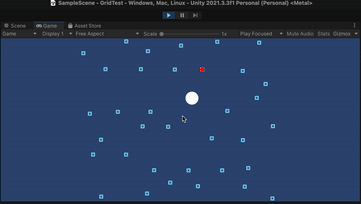

Capture The Sky
ROLE
Lead Designer, Programmer
View Game
YEAR
2023
DESCRIPTION
The sky has lost its king. You play as a child of the Gods of Night and Day, fighting for your rightful claim to the sky in this 2D local multiplayer game. Create triangular constellations to capture area and planets by moving between stars.
The more time you have an area captured, the more points you get. Planets add bonus points at the end. Break your opponent's areas by creating a triangle adjacent to theirs!
GENRE
Arcade 1v1 area control
PLATFORM
PC

Design Process

Capture The Sky came about from the SGDA Spring Game Jam, fitting with the theme of Day and Night, and the secondary theme of unorthodox movement. When brainstorming this idea, I knew I wanted our game to be simple from the get-go, and to have local, arcade-like multiplayer so people at the event could play against each other. As me and my team reached common ground, we landed on an idea drawing from personal experience: a connect the dot game I used to play with my mother in restaurants where we would draw a grid on a napkin and capture squares, taking turns to draw lines between the points. However, to fit with the theme, we evolved the idea to connect stars, so we could have both a fun experience, and a pretty game where you create unique constellations mid-battle.

One challenge we faced while developing the game was how the capturing system would work. We knew we wanted areas to give points over time, but how much would we be able to capture at a time? How would capturing flags work? When does one player win over the other? These were all questions we asked ourselves and had in-depth discussions about, and often disagreed on; eventually, we found the answer under the unity of the mechanics. Capturing area would grant points over time based on the area size, while capturing flags would give big bursts of points instead of having to move a flag across captured area, as was the original plan. In order to stop a player from getting points, the opposing player would have to capture an area adjacent to a completed triangle. Additionally, players with a lot of lines would have an advantage because movement within lines increased their travel speed between stars. Overall, our one mechanic of creating lines to capture areas fueled all our other design decisions.


We had differing ideas on how to get the graph to work, and did many tests with offsets and placement. Some things we had to hard-code in, such as boundaries, and other things we left up to mathematical functions and chance.



When it came to visual design, I took on the mantle alongside our two artists. Having a background in art and programming, knowing how to work Unity's engine, I worked in post processing effects and the layout for UI, particle effects, and the capture areas. Normally, this wouldn't have so much to do with game design, but for a game like this, this feedback was imperative to the game feel, not to mention that the neon look added to that idea of retro arcade games that inspired the design in the first place. What we ended up with is a game that looks and feels great!

And we still have more ideas to add to the game. Using this same capture mechanic, we could potentially create more game modes, like one where powerups appear that, once captured in place of planets, can boost or hinder players, somewhat in the style of Mario Kart.
If you've made it this far, thank you so much for reading. I hope you'll try out our game with someone, and have fun!